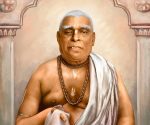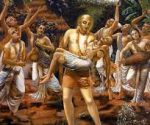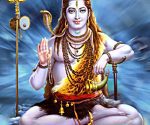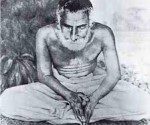World of Compassion
May 01, 2013 (VNN) By Swami B. V. Tripurari via Harmonist
 maya-bhartajanda-sanghasrayangah
maya-bhartajanda-sanghasrayangah
sete saksat karanambhodhi-madhye
yasyaikamsah sri-puman adi-devas
tam sri-nityananda-ramam prapadye
I offer my full obeisances unto the feet of Sri Nityananda Rama, whose partial representation called Karanodakasayi Vishnu, lying on the Karana Ocean, is the original purusa, the master of the illusory energy, and the shelter of all the universes.
The Godhead’s desire to bestow liberation—his compassion—requires another world. Thus from the trans-spatial, timeless realm of Vaikuntha, the world of time and space manifests, and in the above verse, Krsnadasa Kaviraja identifies the deity from whom our world issues forth. Maha Sankarsna of Vaikuntha incarnates as Karanadakasayi, also known as Mahavisnu. He is the adi avatara, the original avatarathrough whom all other avataras appear. He is sometimes described as having thousands of heads and hands for this very reason: innumerable avataras manifest through him.1 In this verse, Sri Krsnadasa refers to him as “adi deva puman,” the original Person/God. However, he is the original God only in terms of those manifestations of the Godhead who cross from up to down (ava-tara), from the trans-spatial realm into time and space. Rather than presiding as Maha Sankarsana does, far beyond maya—mayatite— in his form as Mahavisnu, he is the master the maintainer of maya—maya bharta. And here the objective world of time and space is referred to as an “egg.” The words “aja” and “anda” speak literally of “unborn eggs.” The master of maya manifests the cluster of unborn eggs. With his glance of consciousness that arouses matter, nature takes shape and the multiverse is formed. The un-hatched, egg-like universes are said to be so numerable that they emanate form Mahavisnu’s pores. The truth is that they are numberless, as the entire expanse of time and space knows no bounds. The attempt to measure it with any finality is the folly of the influence of maya-sakti. Maya means “illusion” and well as “to measure.” And the measure of its illusory power is itself inestimable.2
Furthermore while the universes are said to emanate from Mahavisnu, in another sense they are unborn in that even when unmanifest, the entire multiverse remains within the body of God. As the Bhagavad-gita declares, the world rests within the unmanifest form of God—jagat avyakta murtina. He is the soul of the world that is his body. In other words, the world is dependent upon him as the body is dependent upon the soul. But unlike our souls, which are dependent upon our bodies to act in this world, the Godhead is in no way dependent upon the world. Objections to such panentheism with regard to the world’s imperfections being God’s imperfections—if the world is in some sense God, it’s flaws are God’s flaws, as well—do not hold up. Not only does the dependent relation between the world and God run only one way (the world being dependent, God not), but moreover the world’s defects do not affect God.
The word “karana” in this epithet for Mahavisnu—Karanambodhi-—means “cause.” He is the first cause, even as he himself has nothing to accomplish, depicted as he is floating comfortably on a raft within the “causal ocean”—karana ambhodhi— an ocean of cit that is causal only in that it is the resting place of the first cause. And the world of Mahavisnu’s concern, his jurisdiction, is the world of cause and effect—the realm of karma as opposed to the realm of lila. While he is involved in this world as its creator, his participation is nonetheless distant. He is more of a witness, whose watch or glance sets the world ofkarma in motion, while he himself remains aloof from karma’s influence. As first cause he is merely expressing his fullness, and thus the world is manifest out of joy and not for any necessity on the part of the Godhead. The One, it is said, becomes many out of ananda, a love that transcends reason. The sutrasof Vyasa concisely state it thus; lokavat tu lila kaivalyam: “The motive of God in manifesting the world is only sport, as we see in ordinary life people sometimes dance for no reason other than joy.” In other words, his “creation” is motiveless and thus lila. But in the srsti-lila we find lila transitioning into karma. The two, lila and karma, are worlds apart. However, Mahavisnu’s sristi-lila sets the world of karma in motion. While he does not enter this world, he glances at it and thus his amsabhasa or reflection of himself in the form of innumerable jivas merged in homogeneity enters the world, one which lacks causal closure.3
At first sight, dualism appears palpable in the world of Mahavisnu. There is consciousness and there is matter, two different substances very much unlike one another. Consciousness is the mover, while matter is moved. In today’s world some would be quick to ask that if consciousness moves matter, why can’t we observe the interaction between the two? Perhaps the best answer to this query, which implies that dualism is false and consciousness is not causal, lies in exploring the depths of the implications of the very power to observe. In other words, the act of observation itself is above matter’s pay-grade, and when it is understood as such through spiritual practice, the reality of consciousness’ causal role becomes evident. One has to do the spiritual math—sadhana.
However, in Mahavisnu’s world, matter, having been moved, also moves itself, and to a large extent. The Gita states that through misidentification with matter the jiva thinks that it is the doer of that which is in actuality done by matter.4 In other words, the brain is responsible for much of what we mistakenly think to be a product of our volition—for much, but not for everything. Nor are we a brain. The neural causal connections discovered by modern science are as influential to our behavior as neuroscience claims to be, but they are not the cause of consciousness itself. Consciousness is only dependent upon the brain in the manner that a driver’s speed is dependent upon the particular car he is driving. Consciousness expresses itself relative to the body it identifies with. And it experiences the world vicariously, witnessing through neuronal causal connections involving interactions between subtle (mind) and gross (brain) matter, which in and of themselves do not experience at all. And as macrocosmically there is power in the glancing—the witnessing of Mahavisnu—microcosmically there is also power in the witnessing of the individual observer, the jivatma. Indeed, often something particular happens only because someone is present as a witness.
Thus, arguably substance dualism in the strictest sense is not entirely at play in Mahavisnu’s world. While consciousness is causal, at the same time matter causes much of what we mistakenly attribute to consciousness, and furthermore both consciousness and matter are not entirely different substances. Matter “shapes” the extent to which consciousness is expressed and in this sense alone consciousness is partially dependent upon matter, an idea not foreign to a number of today’s prominent thinkers.5Furthermore, both matter and consciousness are saktis of Bhagavan and therefore the world of Mahavisnu is a nondual/monistic world consisting of God (the energetic) and his saktis (its energies) that have no existence independent of him. Jiva-sakti and maya-sakti are different from one another in that one is animate and the other inanimate, one conscious the other unconscious, but they are united as energies of their energetic source, with which they are both one and different.
As the glance of Mahavisnu lights the world, he himself becomes engulfed in effulgence.6 With the addition of light, the otherwise dark world is illumined with self-awareness and the power of observation The light of jiva-sakti illuminates and activates the shadow of maya-sakti. The movements of the shadow are a product of light, its partial presence. Because the jivas are an amsabhasa of Mahavisnu, they constitute only partial light and thus cast a shadow. The interplay of partial light and the shadow it casts is the dance of this world, a dim reflection of the lila that animates the world of light—the dhama(light/abode) of Vaikuntha. As a partial manifestation of Vishnu, the jivas bear the stamp of individual identity/ego that he presides over. The Sanskrit word for ego is “ahankara,” literally “I maker.” Thus one’s sense that “I am” comes from Mahvisnu. We are; and we are his, as well. It is he from whom ourselves and the world of our experience issue forth, such that he may experience compassion.
- Laghu-bhagavatamrtam
- Bhagavad-gita 7.14
- Causal closure is the idea of classical physics that the natural world functions as a closed system with no scope for input from anything outside of itself, anything supernatural, be it a soul or god. However, causal closure does come into question to some extent when one considers quantum physics, within which uncertainty is acknowledged.
- Bhagavad-gita 3.27
- Edelmann, Johnathan B. Hindu Theology and Biology, Oxford Press 2012 p. 88
- See Jiva Goswami’s commentary on Brahma-samhita 5.8












